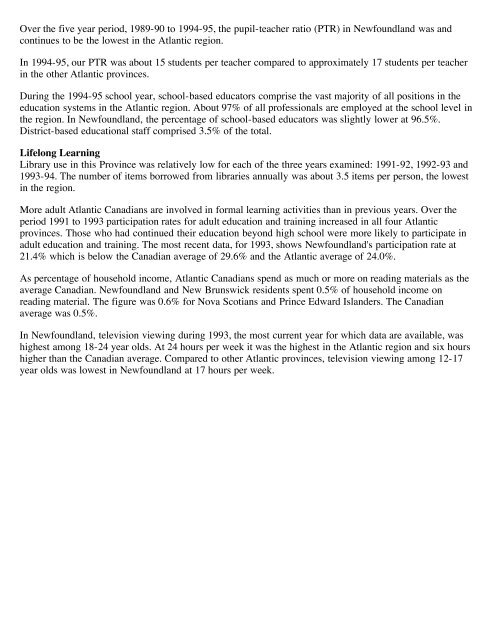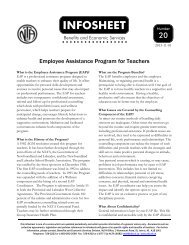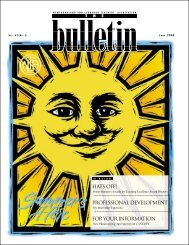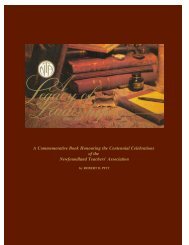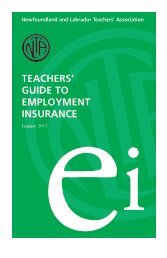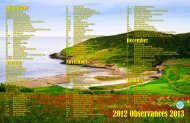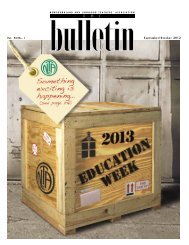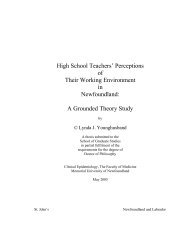males.<strong>The</strong> annual dropout rate was calculated for <strong>the</strong> 1993-94 school year. In this Province, at 11.4%, our annualdropout rate was comparable to Prince Edward Island, higher than New Brunswick and substantially lowerthan <strong>No</strong>va Scotia. <strong>The</strong> rate for males was higher for all provinces, than females. In Newfoundland,approximately 10 males dropped out for every 7 females.<strong>The</strong> subject area participation indicator is <strong>the</strong> approximate number of courses a student attempts in a givensubject area during <strong>the</strong>ir high school years and provides an indicator of <strong>the</strong> relative emphasis placed ondifferent curriculum area. Relative to <strong>the</strong> average for <strong>the</strong> Atlantic provinces, for 1994-95, students in thisProvince enroll in a greater number of Language Arts, Social Studies and Fine Arts courses, fewerMa<strong>the</strong>matics courses and <strong>the</strong> same number of Science courses.<strong>The</strong> latest indicators on university enrolment show that about four out of ten students in Newfoundland enrolin university immediately following high school graduation. This proportion is higher than New Brunswickand Prince Edward Island but lower than <strong>No</strong>va Scotia. A greater proportion of females than males areenroling and this is <strong>the</strong> case in all four Atlantic provinces.Considerable variation exists among provinces with respect to French immersion participation. In <strong>the</strong> 1994-95 school year, participation among provinces ranged <strong>from</strong> about 4.5% in Newfoundland and <strong>No</strong>va Scotiato 18% in New Brunswick.Cost of Education<strong>The</strong> most current date (1993-94) shows <strong>the</strong> operating cost per student was comparable for all four Atlanticprovinces, ranging <strong>from</strong> about $4900 to $5200, and was substantially lower than <strong>the</strong> Canadian average ofapproximately $6000. In Newfoundland, <strong>the</strong> amount was $4929, <strong>the</strong> lowest of <strong>the</strong> four Atlantic provinces.However, Newfoundland's spending on education as a percent of per capita gross domestic product, at30.7%, was <strong>the</strong> highest in <strong>the</strong> Atlantic region. This means that, relative to our ability to fund education,Newfoundland spends more than any o<strong>the</strong>r province.Student SatisfactionAs measured by <strong>the</strong> Quality of School Life (QSL) attitude survey, about four out of ten Grade 8 students inAtlantic Canada indicate a level of dissatisfaction with school.About three out of ten Grade 8 students surveyed say <strong>the</strong>y do not feel safe in school and over half say schoolis a place where students pick on each o<strong>the</strong>r all <strong>the</strong> time.Grade 8 students throughout <strong>the</strong> region have a high regard for <strong>the</strong>ir teachers. In Newfoundland, about eightout of ten students perceive <strong>the</strong>m as fair and competent in helping <strong>the</strong>m. <strong>The</strong>y also have a clearunderstanding of <strong>the</strong> need to get along with o<strong>the</strong>r students and believe school helps <strong>the</strong>m do this.Grade 8 females are overwhelmingly more positive about all aspects of <strong>the</strong>ir school life, than males.While attitudes, as measured by <strong>the</strong> QSL assessment, are generally comparable across <strong>the</strong> provinces,Newfoundland students tend to be more positive about <strong>the</strong>ir schooling experiences than students in <strong>the</strong>Atlantic region as a whole.Conditions of Schooling<strong>The</strong> level of university education completed by educators is increasing. Over <strong>the</strong> four year period 1989-90 to1993-94, in <strong>the</strong> Atlantic region, <strong>the</strong>re were fewer teachers in <strong>the</strong> "no degree" category and a greater numberwho had completed a Master's degree or higher. In Newfoundland, 22% of teachers had Master's degrees <strong>the</strong> highest percentage in <strong>the</strong> Atlantic region.
Over <strong>the</strong> five year period, 1989-90 to 1994-95, <strong>the</strong> pupil-teacher ratio (PTR) in Newfoundland was andcontinues to be <strong>the</strong> lowest in <strong>the</strong> Atlantic region.In 1994-95, our PTR was about 15 students per teacher compared to approximately 17 students per teacherin <strong>the</strong> o<strong>the</strong>r Atlantic provinces.During <strong>the</strong> 1994-95 school year, school-based educators comprise <strong>the</strong> vast majority of all positions in <strong>the</strong>education systems in <strong>the</strong> Atlantic region. About 97% of all professionals are employed at <strong>the</strong> school level in<strong>the</strong> region. In Newfoundland, <strong>the</strong> percentage of school-based educators was slightly lower at 96.5%.District-based educational staff comprised 3.5% of <strong>the</strong> total.Lifelong LearningLibrary use in this Province was relatively low for each of <strong>the</strong> three years examined: 1991-92, 1992-93 and1993-94. <strong>The</strong> number of items borrowed <strong>from</strong> libraries annually was about 3.5 items per person, <strong>the</strong> lowestin <strong>the</strong> region.More adult Atlantic Canadians are involved in formal learning activities than in previous years. Over <strong>the</strong>period 1991 to 1993 participation rates for adult education and training increased in all four Atlanticprovinces. Those who had continued <strong>the</strong>ir education beyond high school were more likely to participate inadult education and training. <strong>The</strong> most recent data, for 1993, shows Newfoundland's participation rate at21.4% which is below <strong>the</strong> Canadian average of 29.6% and <strong>the</strong> Atlantic average of 24.0%.As percentage of household income, Atlantic Canadians spend as much or more on reading materials as <strong>the</strong>average Canadian. Newfoundland and New Brunswick residents spent 0.5% of household income onreading material. <strong>The</strong> figure was 0.6% for <strong>No</strong>va Scotians and Prince Edward Islanders. <strong>The</strong> Canadianaverage was 0.5%.In Newfoundland, television viewing during 1993, <strong>the</strong> most current year for which data are available, washighest among 18-24 year olds. At 24 hours per week it was <strong>the</strong> highest in <strong>the</strong> Atlantic region and six hourshigher than <strong>the</strong> Canadian average. Compared to o<strong>the</strong>r Atlantic provinces, television viewing among 12-17year olds was lowest in Newfoundland at 17 hours per week.


